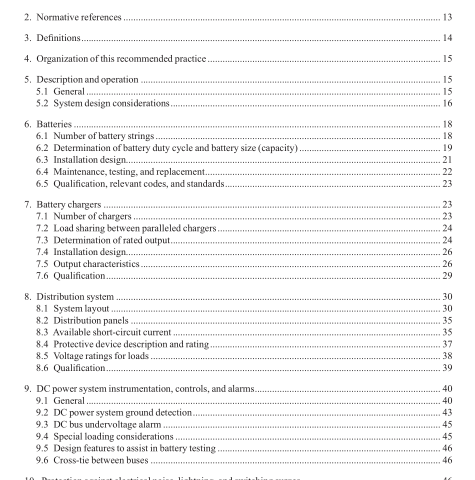IEEE 946-2020 pdf download.IEEE Recommended Practice for the Design of DC Power Systems for Stationary Applications
3. Defnitions
For the purposes of this document, the following terms and definitions shall apply. For terms not defined in this clause, IEEE Std 1881 [B20], IEEE Standard Glossary of Stationary Battery Terminology [B20], and the IEEE Standards Dictionary Online shall be consulted
battery capacity: The quantity of electrical energy, measured in ampere-hours (Ah) or watt-hours (Wh), produced by a battery during discharge.
battery charger: A device to restore and maintain the charge of a secondary battery. For easier reading, “charger” is used throughout this recommended practice to refer to battery charger or a rectifer connected to a battery.
battery state of charge: The stored or remaining capacity in a battery expressed as a percentage of its fully charged capacity.
duty cycle: The sequence of loads a battery is expected to supply for specifed time periods.
nominal battery voltage: The value assigned to a battery of a given voltage class for the purpose of convenient designation.
The operating voltage of the system may vary above or below this value. N+X: Parallel redundancy to ensure that the system is always available. N is the minimum required number of modules/systems. X is the variable referring to extra units needed for reliable operation.
4. Organization of this recommended practice
Stationary dc power systems appear in many applications and industries. All have certain commonalities, while some have some unique requirements. It should be noted that these commonalities or unique requirements are derived from variance in environmental conditions, reliability expectations, and importance of application. That translates to specific feature requirements or technology differences (thyristor versus high-frequency switched mode chargers, or lead-acid versus Ni-Cd batteries) that can provide an engineering approach to the selection/design of dc power systems. For example, a substation charger can be used in a telecom application and vice versa as long as it can meet the requirements. Describing every application is beyond the scope of this document, therefore the three dominant applications are generation, substations, and telecommunications.
Large telecommunication carriers may have their own internal dc power system standards that examine dc power systems and their requirements in detail. This is also beyond the scope of this document, but is worthy of a mention. In this recommended practice, each section includes subparagraphs reserved for these three applications when there are unique requirements. For other industrial applications, one can use the recommendations—in part or as a whole—of one of the three dominant applications.
For example, substation application recommendations may be used, where applicable, for the design of an industrial process control dc power system. It is not the intent of this recommended practice to exclude other industrial applications. Lead-acid and nickel-cadmium batteries are the types of batteries primarily used in these applications. Some other battery technologies may be used but are not fully addressed in this document.
5. Description and operation
DC power systems provide reliable power to critical loads. Examples of critical loads include auxiliary motors, circuit breakers and switchgear, relays, solenoids, SCADA, telecommunications equipment, inverters, emergency lighting equipment, fire suppression equipment, etc.
5.1 General
A dc system normally consists of one or more battery strings, one or more battery chargers/rectifiers and one or more distribution panels. If a battery isolation/protective device is used, refer to the battery protection guidelines of IEEE Std 1375. Refer to simplified typical connection in Figure 1 for the line of demarcation that limits the application of IEEE 946 versus IEEE 1375.
In normal operation, the battery and battery charging system are both connected to the loads through a common bus or via a dc distribution panel. Therefore, they operate as parallel sources. The battery charging system applies voltage and supplies current to the battery in order to maintain a full state of charge in the battery. The charger also generally supplies the continuous load and/or other loads as specifed.IEEE 946 pdf download.IEEE 946-2020 pdf download
IEEE 946-2020 pdf download

Leave a Reply